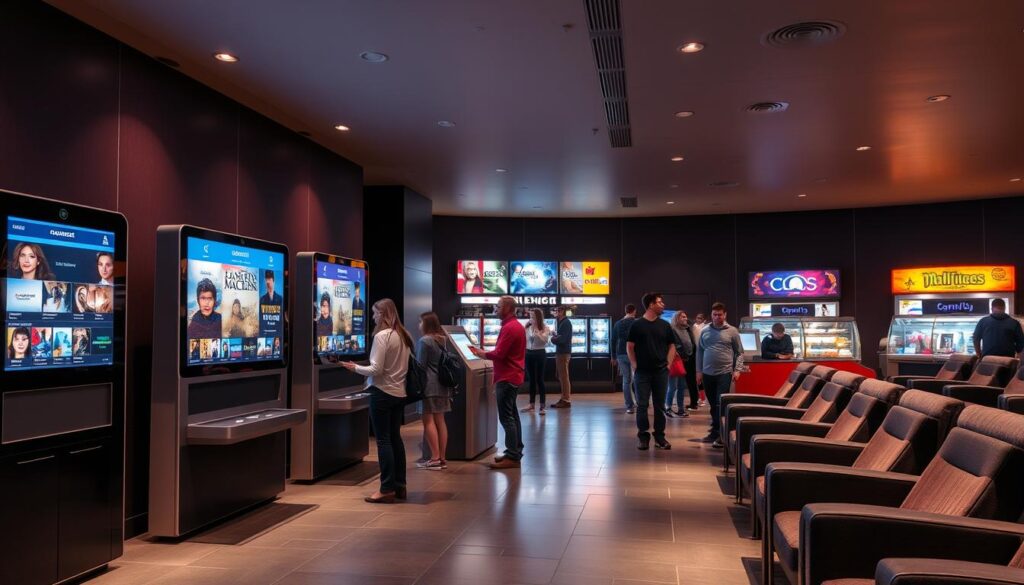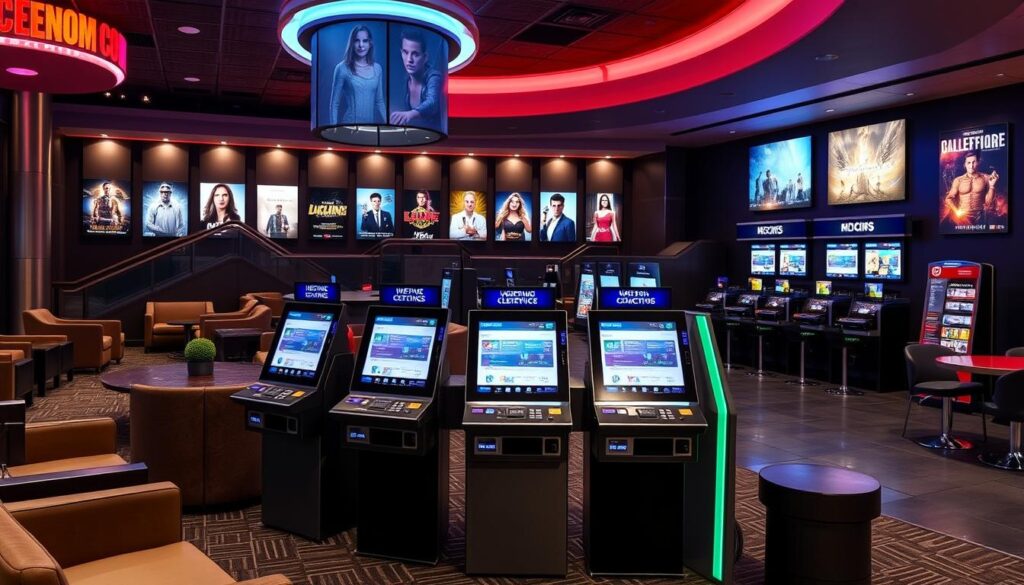In the world of cinema, self-servicing kiosks in cinema are changing how we buy tickets and snacks. The market for these kiosks is expected to hit $63 billion by 2027. They let guests check movie times, buy tickets, pick seats, and order snacks on their own. This meets the changing needs of movie lovers.
These kiosks make things easier, cut down wait times, and offer safe transactions. This is key for today’s shoppers. By letting customers manage their own movie experience, kiosks are making the industry better. They bring happier customers and help cinemas run more smoothly.

Key Takeaways
- Self-service kiosks in cinemas offer customers a convenient, time-saving, and contactless way to purchase tickets and concessions.
- Kiosks can reduce the number of employees needed for ticket sales, leading to cost savings for cinema operators.
- Self-service kiosks facilitate cross-selling and upselling, resulting in increased average transaction values and revenue growth.
- Data collected from kiosk purchases allows for detailed customer behavior analysis and targeted marketing strategies.
- Implementing self-service kiosks can improve operational efficiency and enhance the overall customer experience in cinemas.
The Evolution of Cinema Technology and Self-Service Solutions
The way we watch movies has changed a lot in the last 20 years. Self-service kiosks for tickets and snacks are now common. Big chains like AMC have led this change, adding cool tech like “Perfectly Popcorn” machines. This makes going to the movies better for everyone.
From Traditional Counters to Digital Transformation
The COVID-19 pandemic made self-service tech even more popular in movies. People are okay with buying things online, so cinemas are using kiosks more. They’re teaching customers how to use them and placing them well to make things better.
Market Growth and Industry Adoption
The self-service kiosk market for cinemas is growing fast, with a 6.8% CAGR from 2024 to 2031. This growth is because people want to buy things easily, enjoy their visit more, and save money for theaters.
Current Trends in Theater Technology
- New tech like touchless screens, mobile apps, and AI is making kiosks better for cinemas.
- Things like virtual reality and streaming services are changing how we watch movies.
- Big names like PARTTEAM & OEMKIOSKS and Pyramid are leading in this market.
The movie industry is always changing, and self-service kiosks are key to this change. They help make going to the movies easier and more fun for everyone.
Financial Benefits of Implementing Cinema Self Service Kiosks
Self-service kiosk in cinemas bring big financial wins for theater owners. They make ordering easier and save a lot of labor. This means theaters can work more efficiently and save money.
Reduced Operational Costs
Using self-service kiosks can cut down on costs for cinemas. They can pay off in just 30-60 days by saving on labor. For example, Cineplex in Germany saved 15% on energy, which is about €2,393 a month per site.
Increased Average Transaction Value
Customers often spend more when they use self-service kiosks. This is because the kiosks suggest more items to buy. A study found sales went up by 15% with these kiosks.
Revenue Growth Through Data Analytics
Self-service kiosks give theaters valuable insights on what customers like. This helps theaters make better choices and improve their marketing. With this data, theaters can make more money by targeting the right customers.
On average, 14% of customer transactions are done through self-service kiosks. But some theaters see up to 36% of transactions done this way. By using these kiosks, theaters can improve how they work, increase what customers spend, and use data to grow their revenue.
“Automation systems like EIKONA’s deliver faster savings in energy costs and manpower compared to purchasing new equipment.”
Enhanced Customer Experience Through Self-Service Technology
Today, movie-goers want a smooth, contactless experience. Self-serve kiosk in cinemas are making this possible. They bring more convenience and boost customer happiness.
Kiosks let customers buy tickets and snacks at their own speed. Easy-to-use interfaces guide them through the process. This makes the experience more personal and safe, thanks to the lack of direct staff interaction.
With options like mobile wallets and gift cards, kiosks meet different payment needs. They also help cinemas understand what customers like. This info helps improve the movie-going experience for everyone.
More and more cinemas are using self-service kiosks. They help increase sales, improve customer satisfaction, and make things run smoother. As the contactless movie experience becomes standard, these tools will be key in meeting today’s audience needs.
“Self-service kiosks significantly sped up transactions during busy periods like nights and weekends, reducing the workload on employees.”
| Key Benefits of Self-Service Kiosks | Data Points |
|---|---|
| Increased customer control and convenience Contactless transactions for health and safety Diverse payment options for customer preference Valuable customer behavior insights | 14% average share of customer transactions completed via self-service kiosks in cinemas 36% highest share of transactions completed via self-service kiosks in a cinema 75% of retail executives cited wait-related issues as the #1 reason for losing customers |

Operational Efficiency and Staff Management
Self-service kiosks in cinemas are key to better operations and staff use. They let staff focus on other important tasks. This boosts productivity and service quality.
Workforce Optimization
Self-service kiosks shine during slow times like weekdays. They handle simple tasks, freeing staff for more important work. This makes staff more productive.
Peak Hour Management
At busy times, kiosks speed up transactions. This makes the buying process smoother. Staff can then help with more personal tasks, like marketing or restocking.
Staff Training and Allocation
With kiosks, staff can learn new skills that improve the customer experience. They can focus on tasks that need their expertise and people skills. This leads to better service.
| Metric | Impact of Self-Service Kiosks |
|---|---|
| Operational Costs | Reduced by allocating staff to higher-value tasks |
| Customer Satisfaction | Improved through personalized assistance and reduced wait times |
| Revenue Generation | Increased by streamlining transactions and optimizing staff deployment |
Self-service kiosks help cinemas work better and use staff wisely. This leads to a better customer experience and more revenue in the theater technology world.

“Self-service kiosks are a game-changer for cinema operators, allowing them to streamline operations, improve customer service, and unlock new revenue streams.”
Multi-functional Capabilities of Modern Cinema Self Servicing Kiosks
Cinema technology has changed a lot, bringing in new self-service options. Modern movie ticketing kiosks do more than just sell tickets. They are now central hubs for a wide range of services, making the cinema experience better.
One big plus of these advanced kiosks is buying food and drinks. You can get your tickets and order snacks all in one place. This makes things faster and cuts down on waiting. Plus, you can check your loyalty program info, redeem rewards, and earn points at the kiosk.
These kiosks also give you all the info you need. You can find out about movie times, summaries, and even where to sit. They help you plan your whole visit, from picking a movie to choosing your seat.
Some kiosks can even switch to staff-assisted mode when needed. This makes sure you get the help you want, whether it’s self-service or help from a staff member.
But there’s more. Kiosks can also show ads, deals, and loyalty offers. This makes your visit more fun and can help the theater make more money.
Features like scanning e-tickets for food delivery show how kiosks are getting even better. These all-in-one solutions are changing how we enjoy movies.
“The integration of self-service kiosks in cinemas has shown to reduce long waiting queues significantly.”
Implementation Strategies for Successful Kiosk Integration
Cinema operators are now focusing on adding self-service kiosks to their operations. This move is part of a bigger digital transformation. To make it work, they need to plan carefully and educate their customers.
Top cinema chains are using guides to help customers at first. This personal touch makes people more comfortable with the new technology. Also, moving kiosks around based on how busy it is can really help. This way, more people can use them.
Adding different ways to pay, like credit cards and mobile wallets, makes kiosks more useful. Cinemas can also offer special deals to get people to use the kiosks. This can make buying tickets and snacks easier and faster.
FAQ
What is the projected growth of the self-service kiosk market?
The self-service kiosk market is expected to hit $63 billion by 2027.
What key benefits do cinema kiosks offer?
Cinema kiosks let guests check movie times and buy tickets easily. They can also pick seats and order snacks on their own. This saves labor, boosts efficiency, and gives clear insights into customer behavior.
How have self-service kiosks impacted the customer experience in cinemas?
Self-service kiosks make things easier for customers, cutting down wait times. They also support contactless payments, which people value more now. This gives customers more control over their shopping and accepts various payment methods.
How do self-service kiosks contribute to operational efficiency in cinemas?
Self-service kiosks let staff focus on other tasks, making operations smoother. They work well during busy times and off-peak hours. This means fewer sales need to be handled by employees.
What are the key functionalities of modern cinema kiosks?
Modern cinema kiosks do more than just sell tickets. They handle food and beverage purchases, show movie details, and provide cinema info. They can also act as flexible POS systems when staff help is needed.
What are the key strategies for successful kiosk implementation in cinemas?
For kiosk success, plan well. This includes educating customers, placing kiosks strategically, and supporting various payment methods. Also, offer rewards to encourage using the kiosks.